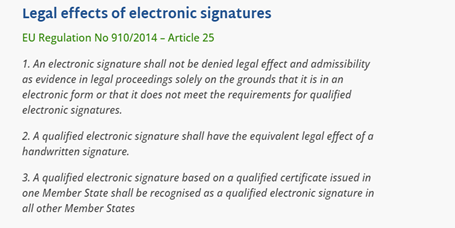
Three types of e-signatures and when to use them
-
11 August 2022
In recent years we have seen the growth of a hybrid approach to the workplace and a massive digital transformation. Every department has a use case for collecting e-signatures and as organizations begin to adopt this technology and implement it to replace legacy traditional processes, it is good to know the different type of e-signatures. In this post we will discuss three types of e-signatures. Firstly, we should look at what an e-signature is. An e-signature is a method by which you attach identity to a document. There are three separate methods that can be used and in recent years we have seen a massive growth across all sectors in a demand for these solutions.
Use Cases
Electronic signatures can be used nearly anywhere. However, there are particularly common use cases, including:
Confusion often arises around the types of electronic signatures and the phrase “digital signature” is often used interchangeably with e-signature but are in fact not the same thing. Online signatures, electronic signatures or e-signatures refer broadly to any electronic process that indicates acceptance of an agreement or a record. The term “digital signature” is frequently used to refer to a certificate-based digital signature, which is a specific type of e-signature. Digital signatures use certificate-based digital IDs from trust service providers (TSPs) to verify signer identity and demonstrate proof of signing by binding each signature to the document with cryptography. Let’s take a look at the different types of e-signatures now:

1. Simple Electronic Signature
A simple electronic signature is the most basic and broadest form of an e-signature. An example of a simple e-signature is a personal email. It is the responsibility of the receiver of the document to trust the signatures as no identity verification is required. Sometime a simple electronic signature may be considered legally binding. However, for many documents, higher qualifications/compliance will be required.
2. Advanced Electronic Signatures
An advanced electronic signature is the next step up from a simple e-signature and these require some form of identity verification. These solutions are usually offered as a platform and an example of advanced e-signatures would be Acrobat Sign offered by Adobe. Under the EU regulation on electronic Identification, Authentication and Trust Services (eIDAS) Advanced Electronic Signature (AdES) is considered legally binding. These types of signatures often suffice for the bulk of the signature requests. They come with an audit report which outlines the exact path the document took, noting IP addresses of who signed the document, email addresses of who approved/signed the document and the timing. These details can be checked and verified.
Adobe have made the process of implementing this technology seamless and easy for anyone to use and as easy as sending an email. (Check out this interactive demo here for Acrobat Sign)
3. Qualified Electronic Signature
The final type of electronic signature we will discuss today is a qualified electronic signature. These are similar to advanced electronic signature but require a higher level of identity verification. Qualified electronic signatures (QES) must have a certificate based on public keys that were issued with proper technological means. The identity of the signatory must have been identified by an audited entity. Essentially the identity of the signatory must have been confirmed by a qualified trust service provider which all governments of EU states must provided a list of. To get an idea of the process required to sign up for a qualified electronic signature check out this ‘How To’ video from TrustPro
In Ireland, the government have elected TrustPro to be the Qualified Trust Service Provider to supply Qualified Electronic Signatures and Micromail act as the only partner for TrustPro in Ireland.
https://www.gov.ie/en/publication/7cbde-trust-service-providers/
Qualified Electronic Signatures are considered the same as handwritten signatures:

Source: eIDAS Regulations
As you can see the landscape for electronic signatures has a variety of options. To establish what solution is most suited to your use case please get in touch with us at info@micromail.ie